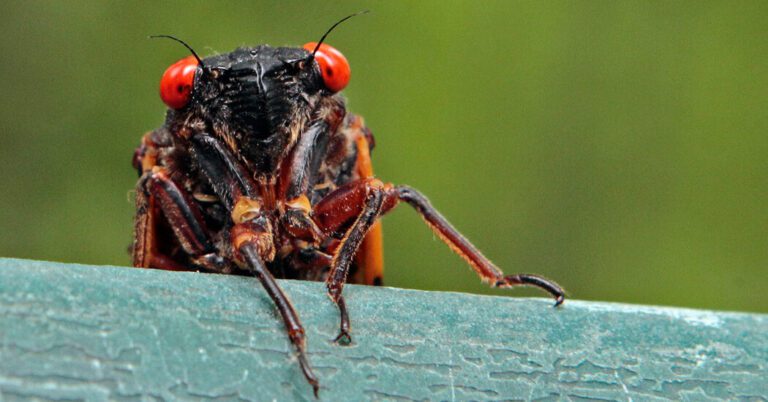
[ad_1]
In a rare occurrence, a trillion cicadas from two different broods are expected to begin appearing in the Midwest and Southeast regions of the United States at the end of April.
It’s the first time since 1803 that Brood XIX, or the Great Southern Brood, and Brood XIII, or the Northern Illinois Brood, will appear together in an event known as a dual emergence.
Thomas Jefferson was president the last time that the Northern Illinois Brood’s 17-year cycle aligned with the Great Southern Brood’s 13-year period. After this spring, it’ll be another 221 years before the groups, which are geographically adjacent, appear together again.
A roughly 16-state area will be center stage for these periodical cicadas, which differ from those that appear annually in smaller numbers.
Forested areas, including urban green spaces, are more likely to see higher numbers of cicadas than agricultural regions. To put into perspective just how many of these bugs could emerge, one trillion cicadas, each just over an inch long, would cover 15,782,828 miles if they were placed end to end, said Floyd W. Shockley, an entomologist and collections manager at the Smithsonian National Museum of Natural History.
“That cicada train would reach to the moon and back 33 times,” Dr. Shockley said.
When are the cicadas coming out?
The first cicadas are expected to start emerging in late April. Temperature determines when they come out, said Gene Kritsky, a retired professor of biology at Mount St. Joseph University in Cincinnati, and the author of several books on cicadas, including “A Tale of Two Broods.”
Professor Kritsky said that first the soil needs to reach 64 degrees Fahrenheit, about six inches deep, and “then you get a good soaking rain, and that’s when they really pop,” he said.
They’ll use their forelegs to tunnel out from the earth, their beady red eyes looking for a spot where they can peacefully finish maturing. A few days after they emerge and molt, the males will start buzzing in an effort to find a mate, a slow-building crescendo of noise that as a chorus can be louder than a plane.
Where will they be?
The first waves of cicadas will emerge in northern Louisiana, southern Arkansas, Alabama, Mississippi, northern Georgia, and up into western South Carolina, Professor Kritsky said.
Then they’ll surface in central North Carolina, eastern Tennessee and northern Arkansas, followed by southern Missouri, Southern Illinois and western Kentucky. Finally, he said, the cicadas will appear throughout central and northern Missouri and Illinois, northwestern Indiana, southern Wisconsin and eastern Iowa.
How long will the dual emergence last?
The Midwest and Southeast should be buzzing for about six weeks.
In most cases, Dr. Shockley said, the cicadas, which live about a month, will die not far from where they had emerged.
Are cicadas dangerous?
Cicadas don’t bite or sting, nor do they carry any diseases. But since they’re “not great fliers and even worse landers,” cicadas often end up on sidewalks and city streets, where they can be squished by people or cars and “could conceivably make things slick.”
“In urban areas, there will be sufficient numbers to necessitate removal of their bodies,” Dr. Shockley said. “But rather than throwing in the trash or cleaning up with street sweepers, people should consider them basically free fertilizer for the plants in their gardens and natural areas.”
If you have a dog that likes to eat them, it’s not good to let them gorge themselves on the insects because it can lead to intestinal blockage, said Professor Kritsky.
How do I get rid of cicadas?
The short answer is: You don’t. If you have delicate plants that you want to protect, then use special netting created for that purpose.
The bugs are beneficial to the environment, acting as natural tree gardeners. The holes they leave behind when they emerge from the ground help aerate the soil and allow for rainwater to get underground and nourish tree roots in hot summer months. The slits they make in trees can cause some branches to break, and the leaves then turn brown in a process known as “flagging,” which is a kind of natural pruning. When the branch grows again, the fruits it yields will tend to be larger. When they die, the cicadas’ rotting bodies provide nutrients that trees need.
John R. Cooley, a biology professor at the University of Connecticut, said that his best advice for people living in the regions of the dual emergence is to let the bugs be.
“The forest is where they live,” he said. “They are a part of the forest. Don’t try to kill them. Don’t try to spray insecticide, all that kind of thing. That’s just going to end badly because there are more than you could possibly kill with insecticide. You’d end up killing everything.”
[ad_2]